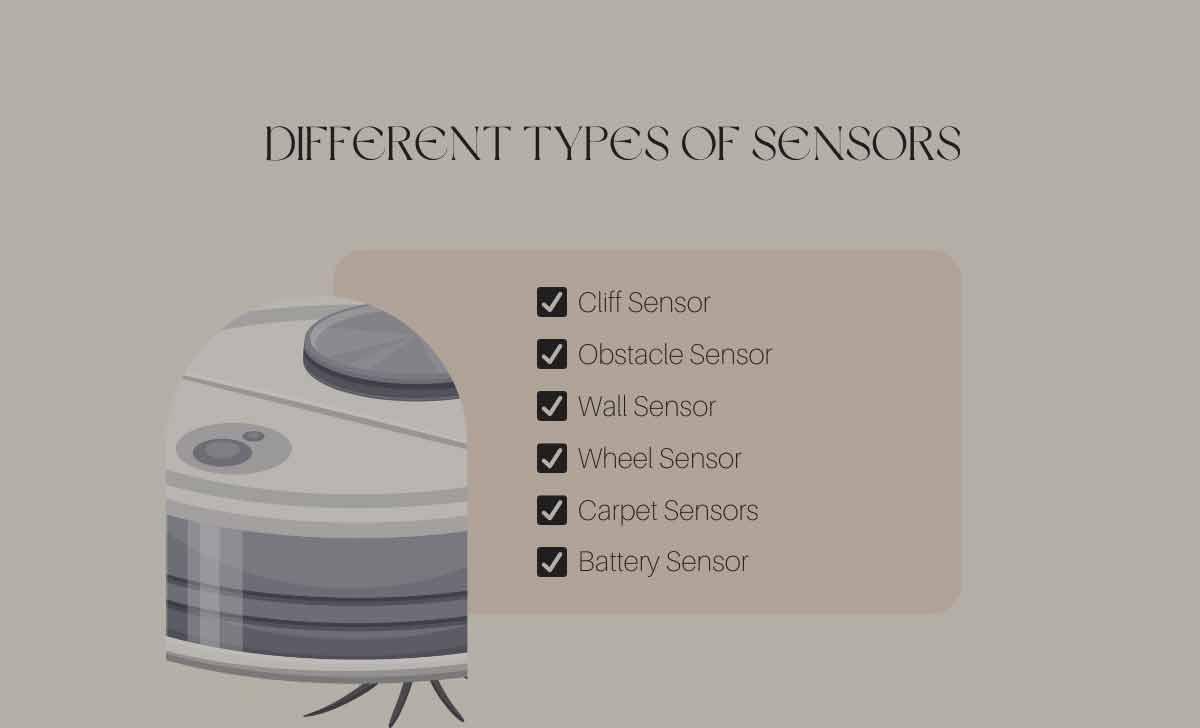Are you curious to know what type of sensors are used by your robot vacuum or if you want to purchase a new one, then it’s mandatory to have knowledge on a different types of sensors available and their use.
Through this article know complete details of sensors used in Robot Vacuum cleaner from basic models to high-end models. Also, learn their uses and functionality for proper understanding.

Robot Vacuum Sensors
Sensors are electronic devices that help the robot vacuum to identify the surrounding and operate it to navigate and clean your house efficiently. There are different types of sensors and each has its own functionality.
Some sensors used to map the house and create a route for cleaning and some are used to avoid obstacles or colliding to furniture present on the floor. So we will discuss about each sensor available in robot vacuum in a detailed way.
But make sure that the Sensors present in the robot completely depend on the model you are using. Not all robots contain the same sensors as it vary from one model to another according to their price range.
Also Check: How to Control My Robot Vacuum Cleaner using Smartphone
Types of Sensors Used in Robot Vacuum Cleaner
There are a variety of sensors available that are used in robot vacuum cleaners and working and the uses of each sensor vary together used to help robot vacuum to clean efficiently.
Cliff Sensor
This sensor is available in almost every robot cleaner. This sensor is based on Laser technology as it uses infrared light. This light reflects back from an object if any object placed in front of robot and informs its presence.
If there is no object present then light won’t reflect back and the robot changes the route to travel. Through this sensor only, it identifies the steps and doesn’t travel in that way.
Obstacle Sensor
The name itself suggests that this sensor is used to avoid any obstacles while cleaning. There are a lot of furniture and tables present on the floor, if the robot comes across or makes contact with furniture, the sensor will go off.
Then it will force to change the cleaning route as the sensor goes off. It is very useful to avoid any damage.
Wall Sensor
Some of the robot vacuums offers edge mode which is used to clean the surface along the boundaries of walls. To do this, robot use Wall sensors to detect walls.
Again Infrared light reflects back from wall and suggests the robot that it is a wall and have to clean along the boundary. Through this robot efficiently clean the surface by not striking the wall.
Wheel Sensor
Wheel sensor is the most basic one and available in basic or low-end models. This will notice the wheel rotations and determine the distance and direction. Other sensors use Infrared, ultrasonic or laser based lights to navigate.
But it only depends on wheel rotation and understand the situation of surroundings. It is not as much accurate when compared to other sensors.
Carpet Sensors
Most of the high-end models of Robot Vacuum cleaners contains Carpet Sensors. This sensors identifies the presence of carpet and avoid mopping on it or can increase the suction power of vacuum to clean the carpet.
Battery Sensor
Thinking that how battery sensor related to navigation and cleaning of your home through robot vacuum. Some of the robot vacuum models offers auto-charge feature.
When your robot is getting out of charge then these sensors activate the robot and informs the battery status and distance from the base station. After calculating both, the robot stops cleaning and returns back to the charging station and gets a full charge, and start cleaning again where it stops previously.
Also read: Different Control Types of Robot Vacuum Cleaner
Importance of Sensors in Robot Vacuum Cleaner
The main characteristic of sensors is to calculate the real-time situations. These sensors used to measure time intervals while cleaning, distance traveled for finding the exact position and direction followed by controlling the pressure when to increase or decrease according to the situation.
All the sensors together works and make the robot vacuum cleaner to perform cleaning efficiently without making any damages.
Conclusion:
So, through this article we discussed detailed note on a different type of sensors and how they help robot vacuum cleaner for functioning and navigating the floor properly.
Having a brief knowledge of the sensors used in robot vacuum is always a better one to purchase a new one or to maintain existing robot vacuum efficiently.